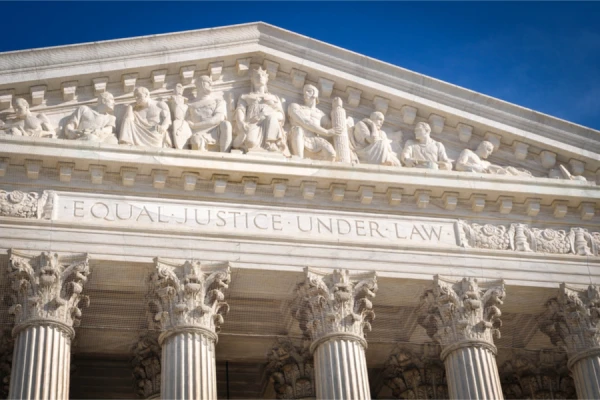
Washington D.C., Aug 30, 2019 / 05:00 pm (CNA).- This week, a Missouri judge ruling against a state pro-life law which was drafted to withstand judicial review. The decision calls into question whether any legislation is possible on abortion in the first two trimesters of pregnancy, and whether a new Supreme Court decision on the issue is now inevitable.
A growing number of state legislatures have passed legislation banning abortions past certain stages of pregnancy.
The laws include “pain-capable” bills—banning abortions after 20 weeks of gestation, a point at which some studies say unborn children can feel pain—and “heartbeat” bills—banning abortions after around eight weeks post-gestation when a baby’s heartbeat can be detected.
In line with Supreme Court precedent, lower courts have consistently ruled that states have no compelling interest allowing them to restrict the constitutional right to abortion found in the case Roe v. Wade , specifically Roe’s finding that “pre-viable” unborn children, or those unlikely to survive outside the womb, are afforded no legal protection, while the abortion of children which could be delivered can be the subject of some state restrictions.
While other state laws ban abortions after a particular stage of pregnancy, Missouri’s 2019 law, sponsored by state Rep. Nick Schroer (R), was unique because it set up multiple bans at various stages of an unborn child’s development, from eight to 20 weeks post-gestation, with the aim of withstanding successive rounds of judicial challenges.
The law was drafted to “withstand different tests” in the courts, Schroer told CNA. A judge would have to consider each separate ban on its merits. Scroer figured this would make at least some bans more likely to survive judicial scrutiny, and thus, he told CNA, the bill would save lives.
Instead, on Aug. 27, Judge Howard Sachs of the Western District of Missouri Court granted an injunction on each of the law’s abortion bans after eight, 14, 18, and 20 weeks, citing Supreme Court precedent to explain that he could not rule any differently.
According to the Supreme Court rulings in Roe v. Wade, Planned Parenthood v. Casey, “viability” has been defined at around 24 to 28 weeks post-gestation, but is ultimately determined by the doctor and the mother.
Steve Aden, chief legal officer and general counsel for Americans United for Life, told CNA that the Missouri judge “just rolled right over” the different bans in the law and, instead of considering each on their specific merits, “tossed them all out in a heap, so to speak, based on Casey.”
According to the judge’s reasoning, the bans violated existing Supreme Court precedent of the “viability” standard; the law “seems designed, as here, as a protest against Supreme Court decisions,” he wrote.
Not all the law’s provisions were struck down; one provision which Judge Sachs called “novel” and which survived, was a ban on abortions for the sole reason of the baby’s race, sex, or a Down Syndrome diagnosis.
Sachs admitted to the moral abhorrence of these cases, but he added that the provision was subject to the same standards as the other bans. At the same time, he found that there was no ground to grant an injunction, since there was no evidence that it would place an undue burden while the law was reviewed.
While an eight-week ban would cover around half the abortions in the state, Sachs said it is unknown how many abortions are currently conducted on the basis of – for example – a Down Syndrome diagnosis, and so it could not be deminstration that such a ban would substantially burden a woman’s right to an abortion in the state.
While the Missouri case will be appealed to a higher court, the question still remains—do states have the authority to enact 20-week or eight-week abortion bans at all? According to Judge Sachs’s finding they do not. His view is that the Supreme Court’s consistent refusal to hear appeals in cases where such laws have been struck down by lower courts amounts to a prohibition by precedent.
Twenty-week bans in states like Arkansas, Arizona and Idaho have all been subject to legal injunction, and the Supreme Court has declined to hear appeals in those cases.
As a result, have called for the Court to reconsider its standards for examining state laws.
Schroer told CNA that while the Court has talked about the “viability” of the baby – namely, its ability to survive outside the womb, it should instead consider the viability of the pregnancy — including cases where a baby might not survive outside the womb, but has a heartbeat, or can feel pain.
Similarly, advancing medical understanding of life inside the womb has led some judges to press for Roe itself to be reconsidered entirely.
A 2018 ruling by the Alabama Supreme Court in Jessie Livell Phillips v. State of Alabama recognized the personhood of unborn children “with value and dignity equal to that of all persons,” and specifically called for the repeal of Roe.
“Return the power to the states to fully protect the most vulnerable among us,” the court’s ruling said.
Others have argued that the Casey decision, and the standards by which state regulations of abortions are judged, were handed down almost 30 years ago. Since then, advances in medical technology have dramatically changed the odds for premature babies outside the womb and advanced society’s understanding of human life in utero through ultrasound machines and other means.
Pro-life advocates and legislators argue that a thirty-year old standard of “viability” is simply no longer relevant.
“Medical advancements have made it possible for infants to live at far earlier stages of development than before,” Lucia Silecchia, a law professor at the Catholic University of America’s Columbus School of Law, told CNA.
If these advancements continue, the “viability” test will become “obsolete,” she said, and “will force us to confront the subjectivity in denying protection to the very young based on their development or location.”
Within the court, Justice Clarence Thomas appeared to call for a new judicial standard in a recent concurring opinion issued in June, when the court refused to hear an appeal after Alabama’s ban on “dismemberment” abortions was overturned by the lower courts.
Thomas wrote that the Constitution allows for states to outlaw such “gruesome” abortions as Alabama did but, because of Casey’s “undue burden” standard, the law had to be struck down as an unlawful obstacle to women accessing abortion.
Calling the standard “demonstrably erroneous,” Thomas called the case “a stark reminder that our abortion jurisprudence has spiraled out of control.”
Thomas said what other federal judges critical of the Court’s abortion jurisprudence have argued—that the Courts have far transgressed their lawful bounds and areas of expertise in abortion jurisprudence and have taken away the authority of states to regulate abortions, instead themselves deciding when unborn children are “viable” and when they are not protected by the law.
Whether the court is willing to reconsider this, however, remains to be seen. But as more states pass legislation aimed at limiting abortion in the light of new medical understanding, pressure and expectation continue to mount.
If you value the news and views Catholic World Report provides, please consider donating to support our efforts. Your contribution will help us continue to make CWR available to all readers worldwide for free, without a subscription. Thank you for your generosity!
Click here for more information on donating to CWR. Click here to sign up for our newsletter.





Leave a Reply